Political Background.
Those were the times of the reign of the Bourbon King Carlos III, with Don José Moñino Redondo, Count of Floridablanca, Prime Minister of Spain since 1776, replacing the Marquis of Grimaldi.
Floridablanca, through the Count of Aranda, the Spanish ambassador in Paris, began systematic aid to the American war effort against Great Britain. The aid materialized first in money and supplies.

On April 28, 1779, Louis XVI of France ratified the renewal of the Family Pact between the two Bourbon kingdoms. And war was declared between them and Great Britain.
This is the century of the wars of kings. Since they are projected and carried out by sovereigns and their ministers. They sought to change the world map for dynastic interests and for the aggrandizement of their Powers. Without even taking into account the feelings of the people.
Background.
On July 9, 1780, a combined war fleet of 22 Spanish and 9 French ships had sailed from Spain, bound for the territorial waters of Great Britain. And in order to attack the enemies he could. An ambitious, broad and clear war mission.
Spain and France harassing the Royal Navy at home. To the Home Fleet, the enemy «home custody fleet».
Commanding our combined fleet was the general command of the Spanish Navy, Admiral Don Luis de Córdova y Córdova, 73 years old. At that age, Córdova was already back from Scholasticism, Thomistics, military or naval regulations, and the art of warfare of force against force.

Córdova‘s fleet was divided into a Spanish division and a French division of ships of the line. Supported by a flotilla of frigates, smaller in length and size than the other ships, but much faster at sea. Intended for exploration tasks (active, intuitive and daring) and security or screen tasks (discreet and hiding from enemy views) of the combined fleet.
The flagship of the Spanish Navy was then the imposing and majestic Santísima Trinidad, the most important sailing ship of the line ever built. She had 4 artillery decks and was launched in the shipyards of Havana, advanced in naval construction.
The Santísima Trinidad was also the flagship of Córdova‘s fleet, where he raised his personal flag. And, she will have a decisive role in the development of future war events
The allied ships were already in the English Channel, when they received the news from Floridablanca, informed by their spies in Great Britain, that two convoys with 52 cargo ships in total, had just set sail from the port of Portsmouth, in the south of England, to India and North America.
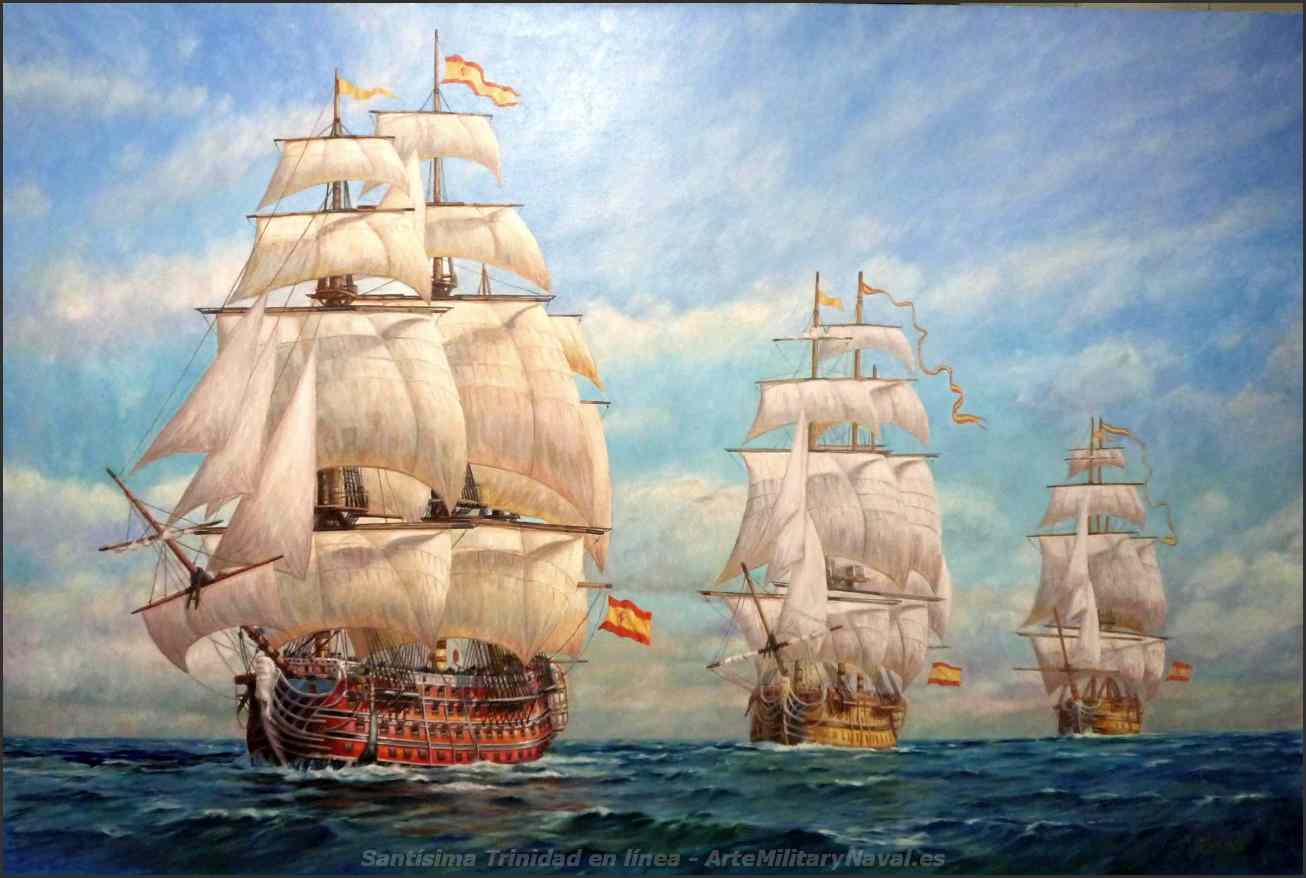
This huge logistics fleet was in itself a necessary and sufficient objective for the tasks entrusted to the Admiral against Great Britain.
Córdova realized that his success lay in calculating with the greatest possible probability, that is, estimating correctly, the strip or sector of course followed by the logistics fleet. With this, he worked out for the combined fleet an interception course for the enemy ships, well to the east of the Azores. That would be confirmed later by his flotilla of frigates on a long-distance reconnaissance mission.
Unfortunately, most of the escort warships of the British logistics fleet returned to their bases, when it was already well under way in the open sea.
Developing.
Towards the first light of dawn on August 9, 1780, dispersed enemy freighters began to appear on the horizon of the combined fleet.
Córdova could attack them, cause them great damage, scatter the rest towards his port and capture a certain spoils. And, thus achieve a great victory.
But, he thought better of fooling them with an «appearance«. And, thus, defeat them one by one, capture them and make an immense booty, which he would take to Spain. And, at a minimum cost of life and damage to ships and their cargoes.
The Admiral ordered a large lantern to be lit and placed on the foremast of the Santísima Trinidad. This was the signal the enemy used to rally their ships around his Captain ship. Appearances, to work for, must be believable and the most expected and natural thing in the world. The enemy will fool himself…
And, the British ships headed towards the Spanish lantern that illuminated them on the horizon, as moths do towards the light…
It is worth remembering that our warships carried a variable crew, depending on their sizes and tasks, from the Spanish Marine Corps. In charge of fighting at sea and on land against enemies as infantrymen. And, that the groups leaders and captains of Córdova were fully trained to carry out the decided maneuvers.
Ahead of the Santísima Trinidad, the ships of the combined fleet fanned out to either side of the horizon, following a rough line. And each one was covered by its port or starboard guns. To receive the British as they deserved when the imaginary bag was closed more.
Some allied ships began their attack on the British freighters, seeing that they abandoned their course and wanted to flee.

From the Santísima Trinidad, they gave and transmitted the «combat order» to the allied groups ships, who transmitted them to the most distant ones. Thus, the rest of the allied ships closed on the scattered and sparse bundle of enemy cargo ships. Attacking them individually.
Let us remember that the cargo ships carried only a symbolic artillery for a minimum defense. Since its structure and displacement were intended to optimize its ability to carry loads for its destination. The artillery, its ammunition, gunpowder and the artillerymen greatly subtracted from its capacity, due to the effective specialization of the means. For its defense, they have the warships escorts.
The enemy, surprised and scattered, was overwhelmed and gave up quickly, once the allied ships were threatening them.
The three warships that were then escorting the British logistics fleet and a freighter escaped from the encirclement, heading for port. Some sources say that the three warships were seized by the allies. And they joined the Spanish Navy. And, they even give their new names as Spaniards.
It took a day to seize all the captured ships. The ring was not, nor could it be, as closed as on land. And, the warships would not surrender at first. Military marines and sailors are not intimidated by a threat and are trained to fight. Theirs is that they fled to the port, once they saw that they could do nothing to defend the freighters. Only to increase the irreparable losses of their nation.
Spanish Marines boarded enemy freighters to subdue and disarm British Trading Companies «soldiers» being flown to colonial duty stations to reinforce garrisons there. And to take the “prey”.
And they would remain in them to control that his sailors carried out the maneuvers to go to the destination ordered by the Admiral of the fleet.
The military operation was effective, clean, profitable and fast. Córdova and his combined attack fleet returned to the Homeland with a huge booty captured from the enemy.
The spoils of war seized by Córdova and his men amounted to:
1,800 “private soldiers” of the West India and East India Trading Companies.
Three thousand British sailors who manned the 51 captured ships.
About 140 million reales (old Spanish coin worth) as the value of the ships, merchandise of all kinds for sale, goods and supplies, weapons and ammunition of the ships and the men of the Companies.
The loss of the logistics convoy destined for the 13 North American colonies dealt a heavy blow to Britain’s war efforts there, against the Native Americans fighting for their Independence.
By August 20, Córdova, his ships, his men, and his enormous booty were reaching Cádiz. Being received in triumph by the local authorities and the people of Cádiz.
Some final considerations.
This Spanish naval feat has little resonance in the History books written since then. As an explanation, we could say that the «Efforts of arms» are always attributed «gunpowder and blood«. As notable, essential and instrumental Additions to them.
And, the Córdova combined fleet Action in the capture of the largest logistics fleet suffered by Great Britain in its history, was quiet (with little gunpowder) and unscathed (without much blood).
And therefore it is assumed to be with little military effort. In other words, without courage, brilliance, stripes, or warlike glory.
We don’t always have a Master Sun (Sun Tzu means that) on our way to understand us. And appreciating a complete victory taking advantage of the weaknesses and failures of the enemy.










 A Panther from the 11th panzer division circa summer 1943
A Panther from the 11th panzer division circa summer 1943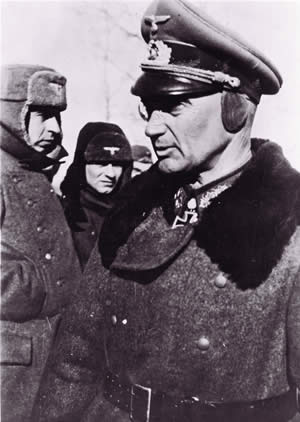 Colonel General Walther Model.
Colonel General Walther Model. The Rzhev’s projection was formed after the Soviet counter-offensive in defense of Moscow.
The Rzhev’s projection was formed after the Soviet counter-offensive in defense of Moscow.